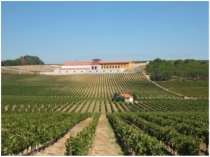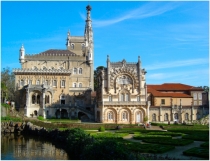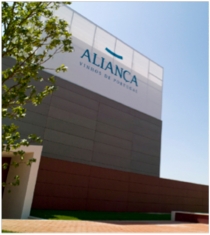Beira Atlântico
Wine region: BEIRA ATLÂNTICO
The Bairrada DO is included within the region which currently bears the designation Beira Atlântico, and the areas under the DO Bairrada formed part of the more extensive viticultural region already mentioned which was known as IG Beiras.
Wine production in the region dates back to Roman times, as evidenced by the wide variety of wine presses hewn out of the granite rock (anthropomorphic wine presses) where wine was produced during this period. Documented evidence of wine production dating to the 10th and 11th century has been discovered. The tradition of these wines dates back to the reign of D. Afonso Henrique, who authorised the planting of vineyards in the region on condition that he received one quarter of the wine they produced. As early as during the reigns of D. João I and D. João III, measures were taken to protect the wines from this area of the country, given their excellent quality and social and economic importance. Extending from the Minho to the Alta Estremadura, it is a region of predominantly intensive agriculture, with a variety of crops grown on small parcels of land, where the vine occupies pride of place and the quality of its wines justifies the recognition that DOC “Bairrada” bestows upon them. The officially approved certification authority for vitivinicultural products entitled to bear the designations of DO Bairrada and IG Beira Atlântico is the Comissão Vitivinícola da Bairrada (Bairrada Vitivinicultural Commission), abbreviated to CVB.
The soils come from various geological eras, but are predominantly poor. They are primarily divided between calcareous clay terrain and long sandy bands, constituting a wide variety of soil types, depending on which element is predominant. Vines are cultivated mainly in clay or calcareous clay soils. The winters are long and cool, the summers hot, tempered by the winds from the east and north‑east dominant in those regions closer to the sea. The climate is a Mediterranean‑Atlantic one, with an annual rainfall of between 900 mm and 1,100 mm. For the most part, the region is flat, with vineyards seldom situated at altitudes higher than 120 metres. Given its flatness and proximity to the ocean, it enjoys a temperate climate with an extremely strong Atlantic influence, with frequent rains and mild average temperatures. Forming of a strip along the coast with a high population density, rural property is divided into thousands of small parcels, with the average area of vine cultivation rarely exceeding one hectare of vines, thus favouring the presence of large cooperative cellars and large winemaking companies as well as a number of producer‑bottlers who are a credit to the region.
The viticultural land of the Beiras region used to cover an extensive area, and used to produce around 13% of the volume of all wines produced in Portugal.
The official borders of the Bairrada were established in 1867 by António Augusto de Aguiar, and it was one of the first regions in Portugal to adopt and develop sparkling wines, given that the region’s cool, humid climate with its strong maritime influence favours its production, yielding grapes with a low alcohol but high acid content, both essential factors in the making of sparkling wine.
(IVV Yearbook, pages 147, 153–157)
Types of vitivinicultural products
Beira Atlântico IG or Beira Atlântico regional wine: White, rosé, red, sparkling, semi‑sparkling, “Terras de Sico” subregion
Bairrada DO wines (VQPRD): Red, red “Classico”, white, rosé.
Bairrada DO sparkling wines (VEQPRD)
Aguardente Bagaceira (grape marc spirit)
Regional Contacts
Technical information: Certification authority: CONSELHO VITIVINÍCOLA REGIONAL DAS BEIRAS (“REGIONAL VITIVINICULTURAL COUNCIL OF THE BEIRAS”), Av. Eng.º Tavares da Silva, 3780‑203 ANADIA, Tel.: 231 510 180 – Website: www.cvbairrada.pt e‑mail: info@cvbairrada.pt
Cultural information on the wine of the region: Confraria dos Enofílos da Bairrada (“Society of Oenophilists of Bairrada”), Estação Vitivinícola de Anadia (“Anadia Vitivinicultural Station”), Tel. 231510330, Museu do Vinho da Bairrada, Av. Eng.º Tavares da Silva, 3780‑203 ANADIA, Tel. 231519780, e‑mail: museuvinhobairrada@mail.telepac.pt
Institutions of higher learning and viticultural research: Escola superior de Coimbra, Benacanta (“Coimbra College, Benacanta”) – S. Martinha de Bispo 3040‑316 Coimbra, www.esac.pt.; Estação Vitivinícola de Anadia (“Anadia Vitivinicultural Station”), Apartado / 3781‑907 Anadia; Tel: 231 510 180 Site: http://www.cvbairrada.pt, e‑mail: info@cvbairrada.pt
Certification authority: CONSELHO VITIVINÍCOLA REGIONAL DAS BEIRAS (“REGIONAL VITIVINICULTURAL COUNCIL OF THE BEIRAS”) COMISSÃO VITIVINÍCOLA DA BAIRRADA (“BAIRRADA VITIVINICULTURAL COMMISSION”) ; Av. Eng.º Tavares da Silva 3780‑203 ANADIA – Tel.: 231 510 180 Fax: 231 510 189; Website: www.cvbairrada.pt e‑mail: info@cvbairrada.pt
Eno‑tourism information: Bairrada Wine Route, situated in the Anadia vitivinicultural regional municipality; Tel.: 231 510 180, Website: www.cvbairrada.pt

Producer and bottler information on wine from the Beira Atlântico http://www.ivv.min‑agricultura.pt/np4/1736.html, → Yearbook 2011, pages 158‑160. www.cvbairrada.pt
Designation: IG “Beira Atlântico” Regional wine
Legislation: Ministerial Directive No. 238 – A/2011, Decree‑Law No. 212/2004, Reg. (EC) No. 1234/2007 (as amended by Reg. (EC) No. 491/2009).
Varieties:
RED WINES: Água‑Santa, Alfrocheiro, Alicante‑Bouschet, Alvarelhão, Aragonez (Tinta‑Roriz), Baga, Bastardo, Cabernet‑Franc, Cabernet Sauvignon, Caladoc, Camarate, Campanário, Castelão (Periquita), Cidreiro, Cinsault, Coração‑de‑Galo, Cornifesto, Espadeiro, Gamay, Grand‑Noir, Jaen, Malvasia Preta, Marufo, Merlot, Monvedro, Moreto, Petit‑ Verdot, Pinot‑Noir, Português‑Azul, Rabo‑de‑Ovelha‑Tinto, Rufete, Sousão, Syrah, Tannat, Tinta‑Barroca, Tinta‑Carvalha, Tinta‑Francisca, Tinta‑Miúda, Tintem, Tinto‑Cão, Touriga‑Fêmea, Touriga‑Franca, Touriga‑Nacional, Trincadeira (Tinta‑Amarela), Vinhão, Xara, Zinfandel, Alvar‑Roxo (R), Folgasão‑Roxo (R), Gewurztraminer (R) e Malvasia‑Fina‑Roxa (R) and Pinot‑Gris (R).
WHITE WINES: Alvar, Alvarinho, Antão‑Vaz, Arinto (Pedernã), Arinto‑do‑ Interior, Assaraky, Azal, Barcelo, Bical, Branca‑de‑Anadia, Cercial, Chardonnay, Chenin, Côdega‑de‑Larinho, Dona‑Branca, Encruzado, Fernão‑Pires (Maria‑Gomes), Folgazão, Folha‑de‑Figueira Fonte‑Cal, Godelho, Gouveio, Jampal, Loureiro, Luzidio, Malvasia‑Fina, Malvasia‑Rei, Pinot‑Blanc, Rabo‑de‑Ovelha, Riesling, Sauvignon, Semillon, Sercial (Esgana‑Cão), Sercialinho, Síria (Roupeiro), Tália, Tamarez, Terrantez, Trajadura, Uva‑Cão, Verdelho, Verdial‑Branco, Viognier, Viosinho and Vital
Designation: IGP “Terras do Sico” subregion
RED WINES: Alfrocheiro, Baga, Bastardo, Rufete, Touriga Nacional and Trincadeira (Tinta Amarela).
WHITE WINES: Arinto (Pedernã), Cercial, Fernão Pires (Maria Gomes), Rabo de Ovelha and Tália.
Designation: DOP “Bairrada” VQPRD

(varieties in bold)
Legislation: Decree‑Law No. 301/2003, Ministerial Directive No. 836/2004, Reg. (EC) 1493/99.
Varieties:
RED WINES: Alfrocheiro*, Baga*, Camarate*, Castelão (Periquita1)*, Jaen* and Touriga Nacional*, together or separately must contain at least 85% of the specified grape variety or varieties, but must also contain at least 50% of the Baga variety; Aragonez (Tinta Roriz), Bastardo, Cabernet Sauvignon, Merlot, Pinot Noir, Rufete, Syrah, Tinta Barroca, Tinto Cão and Touriga Franca.
WHITE WINES: Arinto (Pedernã), Bical, Cercial, Chardonnay, Fernão Pires (Maria Gomes), Pinot Blanc, Rabo de Ovelha, Sauvignon, Sercealinho and Verdelho.






